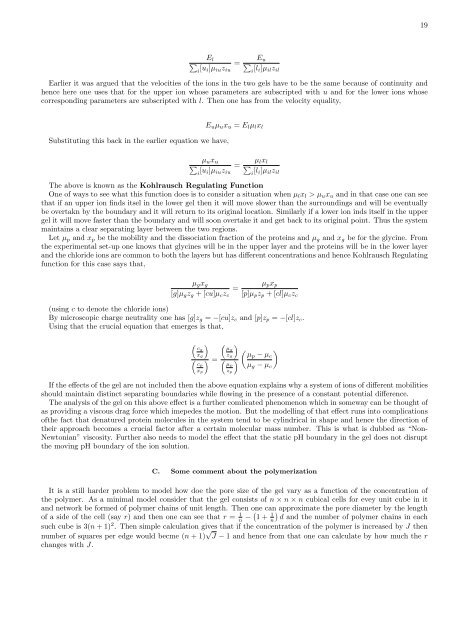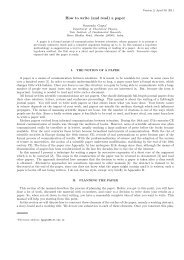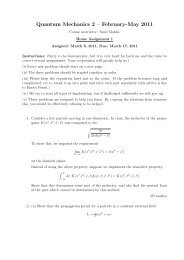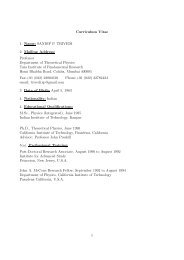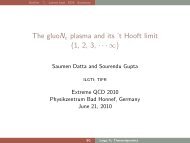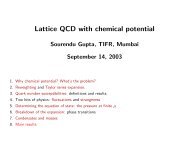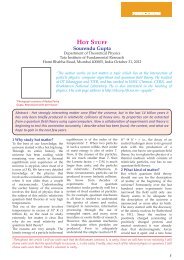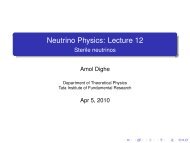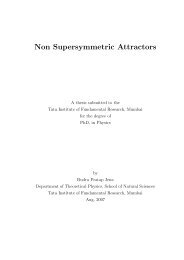A report on an experiment I did of doing electrophoresis with proteins
A report on an experiment I did of doing electrophoresis with proteins
A report on an experiment I did of doing electrophoresis with proteins
You also want an ePaper? Increase the reach of your titles
YUMPU automatically turns print PDFs into web optimized ePapers that Google loves.
19<br />
E l<br />
∑i [u i]µ iu z iu<br />
=<br />
E u<br />
∑<br />
i [l i]µ il z il<br />
Earlier it was argued that the velocities <strong>of</strong> the i<strong>on</strong>s in the two gels have to be the same because <strong>of</strong> c<strong>on</strong>tinuity <strong>an</strong>d<br />
hence here <strong>on</strong>e uses that for the upper i<strong>on</strong> whose parameters are subscripted <strong>with</strong> u <strong>an</strong>d for the lower i<strong>on</strong>s whose<br />
corresp<strong>on</strong>ding parameters are subscripted <strong>with</strong> l. Then <strong>on</strong>e has from the velocity equality,<br />
Substituting this back in the earlier equati<strong>on</strong> we have,<br />
E u µ u x u = E l µ l x l<br />
µ u x u<br />
∑i [u i]µ iu z iu<br />
=<br />
µ l x<br />
∑ l<br />
i [l i]µ il z il<br />
The above is known as the Kohlrausch Regulating Functi<strong>on</strong><br />
One <strong>of</strong> ways to see what this functi<strong>on</strong> does is to c<strong>on</strong>sider a situati<strong>on</strong> when µ l x l > µ u x u <strong>an</strong>d in that case <strong>on</strong>e c<strong>an</strong> see<br />
that if <strong>an</strong> upper i<strong>on</strong> finds itsel in the lower gel then it will move slower th<strong>an</strong> the surroundings <strong>an</strong>d will be eventually<br />
be overtakn by the boundary <strong>an</strong>d it will return to its original locati<strong>on</strong>. Similarly if a lower i<strong>on</strong> inds itself in the upper<br />
gel it will move faster th<strong>an</strong> the boundary <strong>an</strong>d will so<strong>on</strong> overtake it <strong>an</strong>d get back to its original point. Thus the system<br />
maintains a clear separating layer between the two regi<strong>on</strong>s.<br />
Let µ p <strong>an</strong>d x p be the mobility <strong>an</strong>d the dissociati<strong>on</strong> fracti<strong>on</strong> <strong>of</strong> the <strong>proteins</strong> <strong>an</strong>d µ g <strong>an</strong>d x g be for the glycine. From<br />
the <strong>experiment</strong>al set-up <strong>on</strong>e knows that glycines will be in the upper layer <strong>an</strong>d the <strong>proteins</strong> will be in the lower layer<br />
<strong>an</strong>d the chloride i<strong>on</strong>s are comm<strong>on</strong> to both the layers but has different c<strong>on</strong>centrati<strong>on</strong>s <strong>an</strong>d hence Kohlrausch Regulating<br />
functi<strong>on</strong> for this case says that,<br />
µ g x g<br />
[g]µ g z g + [cu]µ c z c<br />
=<br />
µ p x p<br />
[p]µ p z p + [cl]µ c z c<br />
(using c to denote the chloride i<strong>on</strong>s)<br />
By microscopic charge neutrality <strong>on</strong>e has [g]z g = −[cu]z c <strong>an</strong>d [p]z p = −[cl]z c .<br />
Using that the crucial equati<strong>on</strong> that emerges is that,<br />
(<br />
cg<br />
x g<br />
)<br />
(<br />
cp<br />
x p<br />
) =<br />
(<br />
µg<br />
)<br />
z g<br />
( )<br />
µp<br />
z p<br />
( )<br />
µp − µ c<br />
µ g − µ c<br />
If the effects <strong>of</strong> the gel are not included then the above equati<strong>on</strong> explains why a system <strong>of</strong> i<strong>on</strong>s <strong>of</strong> different mobilities<br />
should maintain distinct separating boundaries while flowing in the presence <strong>of</strong> a c<strong>on</strong>st<strong>an</strong>t potential difference.<br />
The <strong>an</strong>alysis <strong>of</strong> the gel <strong>on</strong> this above effect is a further comlicated phenomen<strong>on</strong> which in someway c<strong>an</strong> be thought <strong>of</strong><br />
as providing a viscous drag force which imepedes the moti<strong>on</strong>. But the modelling <strong>of</strong> that effect runs into complicati<strong>on</strong>s<br />
<strong>of</strong>the fact that denatured protein molecules in the system tend to be cylindrical in shape <strong>an</strong>d hence the directi<strong>on</strong> <strong>of</strong><br />
their approach becomes a crucial factor after a certain molecular mass number. This is what is dubbed as “N<strong>on</strong>-<br />
Newt<strong>on</strong>i<strong>an</strong>” viscosity. Further also needs to model the effect that the static pH boundary in the gel does not disrupt<br />
the moving pH boundary <strong>of</strong> the i<strong>on</strong> soluti<strong>on</strong>.<br />
C. Some comment about the polymerizati<strong>on</strong><br />
It is a still harder problem to model how doe the pore size <strong>of</strong> the gel vary as a functi<strong>on</strong> <strong>of</strong> the c<strong>on</strong>centrati<strong>on</strong> <strong>of</strong><br />
the polymer. As a minimal model c<strong>on</strong>sider that the gel c<strong>on</strong>sists <strong>of</strong> n × n × n cubical cells for evey unit cube in it<br />
<strong>an</strong>d network be formed <strong>of</strong> polymer chains <strong>of</strong> unit length. Then <strong>on</strong>e c<strong>an</strong> approximate the pore diameter by the length<br />
<strong>of</strong> a side <strong>of</strong> the cell (say r) <strong>an</strong>d then <strong>on</strong>e c<strong>an</strong> see that r = 1 n − ( 1 + 1 n)<br />
d <strong>an</strong>d the number <strong>of</strong> polymer chains in each<br />
such cube is 3(n + 1) 2 . Then simple calculati<strong>on</strong> gives that if the c<strong>on</strong>centrati<strong>on</strong> <strong>of</strong> the polymer is increased by J then<br />
number <strong>of</strong> squares per edge would becme (n + 1) √ J − 1 <strong>an</strong>d hence from that <strong>on</strong>e c<strong>an</strong> calculate by how much the r<br />
ch<strong>an</strong>ges <strong>with</strong> J.


